Pilatus PC-7
The Pilatus PC-7 Turbo Trainer is a low-wing tandem-seat training aircraft, designed and manufactured in Switzerland by Pilatus Aircraft. The aircraft is capable of all basic training functions, including aerobatics, instrument, tactical, and night flying.[1]
| PC-7 | |
|---|---|
.jpg.webp) | |
| PC-7 Team of the Swiss Air Force | |
| Role | Trainer aircraft |
| Manufacturer | Pilatus Aircraft |
| First flight | PC-7: 12 April 1966 (prototype)[1] 18 August 1978 (production)[1] PC-7 Mk.II M: 28 September 1992[1] |
| Introduction | PC-7: 1978[1] PC-7 Mk.II M: 1994[1] |
| Status | In service |
| Primary users | Mexican Air Force Indian Air Force South African Air Force Royal Malaysian Air Force |
| Produced | 1966–present |
| Number built | >618 |
| Developed from | Pilatus P-3 |
| Variants | Pilatus PC-9 |
The PC-7 was developed from the preceding piston-powered Pilatus P-3,[1] largely differing by the adoption of a turboprop engine, a bubble canopy, and a new one-piece wing. Introduced during the 1970s, it has since developed a sizable presence of the global trainer market.[2] The type has been adopted by in excess of twenty air forces as their ab initio trainer, as well as multiple civilian operators. Over one million hours have reportedly been flown by PC-7s worldwide. In addition to training operations, some aircraft are armed and have been used for combat missions by several customers, including Chad, Iran, and Mexico, often in violation of the relevant export agreement between the customer and the Swiss government.
An improved model of the aircraft, the PC-7 Mk.II M, was developed during the 1990s, by combining the newer airframe and avionics from the PC-9 with the PC-7's smaller turbine engine. Reportedly, in excess of 600 PC-7s have been sold to various operators, the majority of which still being in service. In Pilatus' range of aircraft, the PC-7 has been succeeded by the newer PC-9 and PC-21 trainers.[3]
Development
Origins
Work on what would become the PC-7 commenced during the 1960s. It was based on the earlier piston-powered Pilatus P-3, the initial prototype being produced from the existing prototype P-3, principally differing by the substitution of its Lycoming O-435 engine with a Pratt & Whitney PT6A-20 turboprop power-plant.[1][4] On 12 April 1966, the modified prototype performed its maiden flight.[1] However, the PC-7 programme was abruptly shelved following an accident involving the aircraft.[5] The termination of work was reportedly driven by a lack of market interest.[4]

During 1973, it was decided to restart work on the programme; factors for its revival had included the 1973 oil crisis, the launch of the rival Beechcraft T-34C Turbo-Mentor, and the increasing age of existing trainer aircraft.[4] To support the relaunch, another P-3 was obtained from the Swiss Air Force. After modifications, this aircraft first flew on 12 May 1975. Further extensive modifications followed later in the programme, including the adoption of a new one-piece wing complete with integral fuel tanks, along with an altered tail fin and a bubble canopy. The flight test programme came to a close during Autumn 1977.[4]
On 18 August 1978, the first production aircraft made its first flight.[1] On 5 December of that year, Switzerland's Federal Office of Civil Aviation (FOCA) issued civil certification for the PC-7;[4] immediately thereafter, initial deliveries of production aircraft commenced to customers Burma and Bolivia.[6] Over time, sales of the PC-7 generated considerable profits, allowing the company to finance the development of further types of aircraft.[7]
Further development
The PC-7 Mk.II M is a development of the PC-9's airframe and avionics, which was powered by the PC-7's smaller turbine engine, which reportedly achieved lower operating and maintenance costs. This variant was developed at the behest of the South African Air Force (SAAF), who later adopted the type.[8] A batch of 60 PC-7 Mk.II Ms were locally assembled in South Africa using kits supplied by Pilatus for the SAAF; due to political considerations, these aircraft were not fitted with the armament hardpoints. Deliveries to the SAAF took place between late 1994 and 1996.[4]
In addition to Pilatus' own improvement programmes, several third-party companies have independently developed their own upgrades for customer's PC-7. During the late 1990s, Israeli engineering firm Radom began offering a kit of new avionics for the type, which included a new mission computer, a wide-angle head-up display, along with various replacement communications and weapons-delivery systems.[9]
During July 1998, Pilatus announced that it has come to an agreement with American company Western Aircraft, for the latter to act as a distributor for the PC-7 across the North American civil aviation market.[10] At this time, there were already five civil-registered PC-7s in operation in North America; Pilatus believed that the region could be a viable market for both remanufactured and newly built examples of the type, which would be priced between $1 million and $2 million respectively. It was recognised that this market was limited, Western Aircraft expected to sell only a few aircraft per year.[10]
Operational history
General use
All export sales of the PC-7 are subject to approval by the Swiss Government, whose authorisation is required prior to any delivery taking place.[11] The sale of combat-capable aircraft has been a controversial matter at times, and political pressure has been applied for PC-7s to be shipped without the fittings for armaments being installed. The Swiss government has occasionally held up or outright refused to issue export licences for some nations, a move which has reportedly led to the loss of several potential sales, such as to South Korea and Mexico.[11]
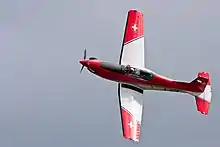
In addition to its adoption by numerous military customers, the PC-7 has also been used by private customers. It has been certified for civil use by both the Federal Office of Civil Aviation (FOCA) and the U.S. Federal Aviation Administration (FAA) as compliant with regulations pertaining to general aviation (GA) operations in both Europe and the United States.[4] Amongst its uses in the civilian sector has been aerobatic displays.[4]
During the 1990s, the PC-7 Mk.II M was adopted as the basic trainer of the Royal Brunei Air Force (RBAirF) alongside the BAE Systems Hawk jet trainer; the acquisition was seen a key to its expanded operations with fixed-wing aircraft.[12][13]
During June 2011, the Indian Air Force (IAF) selected the PC-7 Mk.II M as its new basic trainer, signing a contract for an initial batch of 75 aircraft, with an option for buying an additional 38 PC-7 Mk.II Ms; the Indian military had a total requirement of 181 trainers.[14] The fast-tracked decision to procure a foreign aircraft over a domestically developed alternative proposed by Hindustan Aeronautics Limited (HAL) was a controversial one; retired Air Marshal Anil Chopra argued that HAL had no viable design for the role, and that the IAF could not have reasonably afforded the delay involved in the development of such an aircraft.[15] The procurement of an additional 106 trainers under the 'Make & Buy' (Indian) category was repeatedly deferred. In 2017, the maintenance agreement with Pilatus lapsed, resulting in the IAF becoming solely responsible for performing these activities.[16] During 2018, India announced that it had chosen to exercise the option of buying a batch of 38 trainers.[17]
Combat use
A number of PC-7s were employed by the Guatemalan Air Force in air strikes and for close air support (CAS) during the Guatemalan civil war, starting in 1982, until the end of the conflict in 1996. The PC-7s were typically deployed from the airfield in La Aurora, being armed with a mixture of gun pods and rocket pods.[18]
During the lengthy Iran–Iraq War of the 1980s, amid tensions between Iran and the United States, it is alleged that Iranian officials threatened to arm its PC-7 fleet with explosives and use them to launch suicide attacks against United States Navy (USN) vessels present in the Persian Gulf.[19] Iran reportedly trained a number of suicide pilots and flew some operational missions, training was performed at Bushehr Air Base in Iran and overseas in North Korea.[20][21] In early 1984, an Iranian attack helicopter AH-1J Sea Cobra was shot down by an Iraqi PC-7 during Operation Khyber (Iranian pilots Reza Moghadam and Mohammad Yazdi were rescued).[22]
In 1994, the Mexican Air Force used several armed PC-7s to attack units of the Zapatista Army of National Liberation during the Chiapas conflict in Mexico. This action was considered illegal by the Swiss government because the aeroplanes were sold for training purposes only, and as result, Switzerland issued a ban on the sale of additional units to Mexico.[23] At the time, the Mexican Air Force was the largest single export operator of the type, and had been seeking to acquire further PC-7s, thus the sales ban was viewed as an economic blow to Pilatus.[11]
During the mid to late 1990s, Executive Outcomes, a private military contractor led by Eeben Barlow, utilised three armed PC-7s (ex-Bophuthatswana Air Force aircraft) to provide close air support (CAS) during its operations in Sierra Leone.[24][25]
During the late 2000s, the Chadian Air Force reportedly used its small fleet of PC-7s to bomb rebel positions both in their own territory and in neighbouring Sudan.[26] The Swiss government summoned the Chad's ambassador to request an explanation for these reports, as these actions breached the export agreements previously struck for the sale of the type to Chad.[27]
Variants
- PC-7 : two-seat basic trainer aircraft, powered by PT6A-25A engine rated at 410 kilowatts (550 shaft horsepower).[28]
- PC-7 Mk.II M : a development of the PC-9's airframe and avionics, retaining the PC-7's wing to mount external stores. Powered by PT6A-25C of 522 kilowatts (700 shaft horsepower) rather than more powerful PT6A-62 of PC-9.[29] Developed for the South African Air Force (SAAF), and known as the 'Astra'; the aircraft is a hybrid PC-7 and PC-9, either a PC-7 'Heavy' or a PC-9 'Lite', depending on point of configuration.[1]
- NCPC-7 : upgraded version of the standard PC-7 with fully IFR glass cockpit avionics, developed for the Swiss Air Force. The designation NCPC-7 has been provisionally used in the Swiss Air Force to differentiate modernized PC-7s (NC for New Cockpit) from those which were not yet done. It was removed after the improvement of the last of the 28 aircraft in 2009. Consequently, all the Turbo-Trainer took again the designation PC-7.[30]
Operators
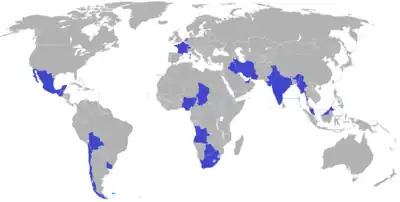
Military operators
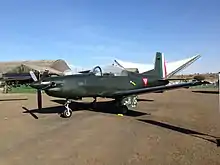
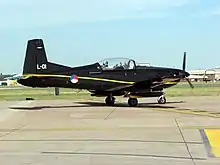

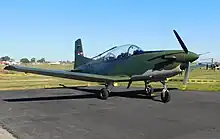
An incomplete list of the users of the PC-7:[1]
- National Air Force of Angola: 12 PC-7 ordered in 1981, with deliveries starting in 1982, 25 total aircraft by October 2008.[1][31]
- Austrian Air Force: 16 PC-7 aircraft in service as of October 2008,[1] 13 aircraft remain in service as of December 2021.[32]
- Bolivian Air Force: 24 PC-7 aircraft in service as of October 2008,[1] 2 remain in service as of December 2021.[33]
- Botswana Defence Force Air Wing: seven PC-7 (delivered from 1990) aircraft in service as of October 2008,[1] to be replaced by five PC-7 Mk.II M in 2013;[34] five PC-7 Mk.II M aircraft formally accepted into service on 8 February 2013, removing six original PC-7s from service.[35]
- Royal Brunei Air Force: four PC-7 Mk.II M aircraft in service as of October 2008,[1] currently operated by No. 73 Squadron, and are also used by the RBAirF Alap-Alap Formation aerobatic display team.
- Chad Air Force: two PC-7[1] aircraft remaining in service as of December 2021.[36]
- Chilean Navy: ten PC-7 aircraft in service as of October 2008,[1] seven aircraft remain in service as of December 2021.[37]
- Direction générale de l'armement: six PC-7 aircraft in service as of October 2008.[1]
- Guatemalan Air Force: 12 PC-7 aircraft in service as of October 2008,[1] one aircraft remaining in service as of December 2021.[38]
- Indian Air Force: 78 PC-7 Mk.II M,[39] India has cancelled ordering 38 more[40] and placed orders for HAL HTT-40.[41]
- Islamic Republic of Iran Air Force: 35 PC-7 aircraft in service as of October 2008,[1] 34 aircraft remain in service as of December 2021.[42]
- Royal Malaysian Air Force: 30 PC-7 Turbo Trainers out of a first order of 44 (delivered from 1983), 45 PC-7 aircraft in service as of October 2008;[1] 17 PC-7 Mk.II M out of a second order of 19 (delivered in two batches, nine from 2001 and ten from 2007); total of 47 currently in service; the type is also used by the Taming Sari aerobatic display team.
- Mexican Air Force: 88 PC-7 aircraft (first delivery May 1979) in service as of October 2008.[1][43]
- Myanmar Air Force: first customer of the PC-7, deliveries in early 1979, 17 PC-7 aircraft in service as of October 2008,[1] 16 aircraft remain in service as of December 2021.[44]
- Royal Netherlands Air Force: 13 PC-7 aircraft in service as of October 2008,[1] 13 aircraft remain in service as of December 2021.[45]
- South African Air Force: first customer of the PC-7 Mk.II M delivered 30 November 1994, 60 PC-7 Mk.II M aircraft in service as of October 2008,[1] the type is also used by the Silver Falcons aerobatic display team.
- Suriname Air Force: two PC-7 aircraft in service as of October 2008 (one transferred to civilian operations).[1]
- Swiss Air Force: 40 (delivered from 1979) PC-7 aircraft in service as of October 2008,[1] 28 PC-7 upgraded with new cockpit in service in 2011;[46] the type is also used by their aerobatic display team PC-7 Team.
- United Arab Emirates Air Force: 31 PC-7 aircraft in service as of October 2008,[1] 31 aircraft remain in service as of December 2021.[47]
- Uruguayan Air Force: 6 PC-7 aircraft in service as of October 2008,[1] 5 aircraft remain in service as of December 2021.[48]
Civilian operators
At least seven PC-7 aircraft are in service by various unspecified civilian operators as of October 2008.[1]
Former military operators
- Bophuthatswana Air Force: two PC-7 (delivered from 1989), later transferred to South Africa Air Force[1] and subsequently served in the Sierra Leone civil war and Chad)
- Iraq Air Force: 52 PC-7 (delivered from 1980)[1]
- Nigerian Air Force had two aircraft in service.
Accidents and incidents
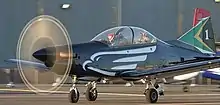
- The South African Air Force (SAAF) grounded their fleet of PC-7 Mk.II M aircraft after a crash on 15 January 2008. The aircraft went down shortly after takeoff from Overberg Air Force Base in the Western Cape Province. SAAF Lieutenant-Colonel Chris Meiring, 58, died shortly after the crash. The aircraft was flying to Langebaanweg Air Force Base for maintenance but shortly after takeoff it rolled and flew into the ground. The cause is believed to have been a structural problem.
- In March 2010, a pilot was killed when his Royal Malaysian Air Force (RMAF) aircraft exploded and caught fire in midair during a solo airshow. This is the fifth accident involving Royal Malaysian Air Force PC-7 aircraft.[49]
- In June 2010, two Mexican pilots were killed when their Mexican Air Force PC-7 crashed after taking off from Pie de la Cuesta, a district in the resort city of Acapulco, Mexico. The PC-7 crashed into the sea near Acapulco.[50][51]
- On 20 October 2011, two PC-7s of the Botswana Defence Force were involved in a mid-air collision over Letlhakeng 100 kilometres (62 miles) west of Gaborone. Two of the four aircrew involved were killed in the accident.[52]
- On 12 September 2017, a pilot was killed when his Swiss Air Force PC-7 crashed at the Schreckhorn in Canton Bern on its way from Base aérienne Payerne to Base aérienne Locarno.[53]
Specifications (PC-7)
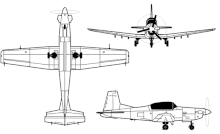
General characteristics
- Crew: two, pilot instructor and student pilot
- Capacity: two
- Length: 9.78 m (32 ft 1 in)
- Wingspan: 10.40 m (34 ft 1 in)
- Height: 3.21 m (10 ft 6 in)
- Wing area: 16.60 m2 (178.7 sq ft)
- Aspect ratio: 6.5:1
- Airfoil: NACA 642A-415 at root, 641A-612 at tip
- Empty weight: 1,330 kg (2,932 lb)
- Max takeoff weight: 2,700 kg (5,952 lb)
- Fuel capacity: 474 L (104 imp gal; 125 US gal) usable internal fuel,
2x 240 L (53 imp gal; 63 US gal) external fuel drop tanks
• Max landing weight: 2,565 kg - Powerplant: 1 × Pratt & Whitney Canada PT6A-25A turboprop, 410 kW (550 hp)(derated from 485 kW (650 shp))
- Propellers: 3-bladed Hartzell HC-B3TN-2 / T10173C-8 constant-speed propeller, 2.36 m (7 ft 9 in) diameter
Performance
- Maximum speed: 412 km/h (256 mph, 222 kn) (max cruise at 6,095 m (19,997 ft))
- Cruise speed: 316 km/h (196 mph, 171 kn) (econ. cruise at 6,095 m (19,997 ft))
- Stall speed: 119 km/h (74 mph, 64 kn) (flaps and gear down, power off)
- Never exceed speed: 500 km/h (310 mph, 270 kn) EAS
- Range: 1,200 km (750 mi, 650 nmi) standard range without external drop tanks, ferry range with external drop tanks, (cruise power, at 5,000 m (16,000 ft) - 20 min reserves)
- Ferry range: 2,630 km (1,630 mi, 1,420 nmi)
- Endurance: 4 hr 22 min
- Service ceiling: 10,060 m (33,010 ft)
- g limits: -3 / +6
- Rate of climb: 10.9 m/s (2,150 ft/min) climb to 5,000 m in 9 min 0 sec
take-off run 780 m at max take-off weight, landing run 505 m at max landing weight
Armament
- Hardpoints: 6 × underwing hardpoints for bombs and rockets with a capacity of 1,040 kg (2,294 lb)[55]
See also
Related development
Aircraft of comparable role, configuration, and era
- Atlas ACE
- Beechcraft T-34 Mentor
- Embraer EMB 312 Tucano
- Grob G 120TP
- PZL-130 Orlik
- Socata TB 30 Epsilon
References
Citations
- "Pilatus PC-7 (inc. list of users)". MilitaryAviation.eu. Military Aviation. 3 October 2008. Archived from the original on 24 October 2016. Retrieved 9 November 2012.
- "Training - Bridging the gap". Flightglobal.com. Flight International. 10 July 2001. Archived from the original on 16 June 2019.
- "Elementary training role for PC-21?". Flightglobal.com. Flight International. 14 August 2001. Archived from the original on 16 June 2019.
- "Pilatus PC-7 Turbo Trainer". ForecastInternational.com. Forecast International. September 1999.
- Air International September 1979, p. 112.
- Air International September 1979, p. 114.
- Wastnage, Justin (26 February 2002). "Pilatus ponders additions to civilian aircraft offering". Flightglobal.com. Flight International. Archived from the original on 16 June 2019.
- Wastnage, Justin (30 April 2002). "Peace dividend". Flightglobal.com. Flight International. Archived from the original on 16 June 2019.
- "Radom offers PC-9 upgrade for training and combat". Flightglobal.com. Flight International. 25 November 1998. Archived from the original on 16 June 2019.
- "Pilatus appoints Western to market PC-7 trainer". Flightglobal.com. Flight International. 22 July 1998. Archived from the original on 16 June 2019.
- "Government veto blocks PC-9 sale to Mexico". Flightglobal.com. Flight International. 8 February 1998. Archived from the original on 16 June 2019.
- "Brunei finalises MPA configuration". Flightglobal.com. Flight International. 18 October 1996. Archived from the original on 16 June 2019.
- "Sultan of Brunei confirms Hawk deal". Flightglobal.com. Flight International. 12 March 1997. Archived from the original on 16 June 2019.
- "India selects Pilatus basic trainer". LiveFistDefence.com (Press release). Pilatus. 24 May 2012. Archived from the original on 2 March 2015. Retrieved 19 June 2011.
- Chopra, Anil (7 October 2013). "Stuck at the basics of aircraft design". TheHinduBusinessLine.com. Hindu Business Line.
- Raghuvanshi, Vivek (20 July 2017). "Swiss Firm not expanding maintenance deal for India's PC-7 trainers". DefenseNews.com.
- "IAF gets its 75th Pilatus training aircraft PC-7 MkII". EconomicTimes.IndiaTimes.com. The Economic Times, India Times. 14 July 2018. Archived from the original on 17 January 2019. Retrieved 14 July 2018.
- Cooper, Tom. "Guatemala since 1954". ACIG.org. Archived from the original on 4 March 2016. Retrieved 31 January 2013.
- Razoux 2015, pp. 421–422.
- Bodansky 1993, p. 14.
- Cordesman and Wagner 1991, p. 285.
- "Потери ВВС Ирана" [Losses of IRIAF]. SkyWar.ru (in Russian).
- Aranda, Jesús (13 November 2009). "Ahora que la FAM pretende renovar su flota no puede adquirir aviones Pilatus C-9". Jornada.unam.mx (in Spanish). La Jornada. Archived from the original on 19 February 2010. Retrieved 9 November 2012.
- Barlow, Eeben. "Executive Outcomes: against all odds". Galago.co.za. Galago. Archived from the original on 29 December 2007. Retrieved 9 November 2012.
- "Gunships for hire". Flightglobal.com. Flight International. 21 August 1996. Archived from the original on 16 June 2019.
- Wezeman, Pieter D. (August 2009). "Arms flows to the conflict in Chad" (PDF). SIPRI.org. Archived from the original (PDF) on 2 June 2013. Retrieved 9 November 2012.
- "Chad likely armed Swiss-made aircraft". SwissInfo.ch. 17 January 2008. Archived from the original on 16 June 2019.
- Air International September 1979, p. 115.
- Taylor 1999, pp. 96–97.
- Pilatus PC-7 Turbo-Trainer, vtg.admin.ch.
- Fontanellaz, Cooper & Matos 2020, p. 26
- Hoyle Flight International 2021, p. 13
- Hoyle Flight International 2021, p. 14
- "Botswana Defence selects PC-7 MkII turboprop trainer aircraft worth SF 40 Mil". FrontierIndia.net. Frontier India. 20 April 2011. Archived from the original on 25 April 2011. Retrieved 9 November 2012.
- Hoyle, Craig (11 February 2013). "Botswana introduces new PC-7 MkII trainers". Flightglobal.com. Flight International, Reed Elsevier. Archived from the original on 14 February 2013. Retrieved 11 February 2013.
- Hoyle Flight International 2021, p. 15
- Hoyle Flight International 2021, p. 15
- Hoyle Flight International 2021, p. 19
- "IAF gets its 75th Pilatus training aircraft PC-7 MkII". EconomicTimes.IndiaTimes.com. New Delhi, India: The Economic Times, Bennett, Coleman & Co. Ltd. 14 July 2018 [10 November 2015]. Archived from the original on 13 November 2015. Retrieved 7 August 2023.
- "IAF shelves 3 major acquisition projects for Make in India, other reasons/". ANInews.in. New Delhi, India: ANI - Asian News International. 19 May 2020. Retrieved 23 May 2020.
- Peri, Dinakar (20 October 2022). "IAF-HAL conclude ₹6,800 crore contract for 70 HTT-40 trainer aircraft". TheHindu.com. Gandhinagar, India: The Hindu, THG Publishing Pvt Ltd. ISSN 0971-751X. Retrieved 21 October 2022.
- Hoyle Flight International 2021, p. 21
- Jackson 2003, p. 454.
- Hoyle Flight International 2021, p. 25
- Hoyle Flight International 2021, p. 25
- "Pilatus NCPC-7 (PC-7 Turbo-Trainer)". LW.admin.ch. Swiss Air Force; Federal Department of Defence, Civil Protection and Sport. Archived from the original on 22 February 2012. Retrieved 9 November 2012.
- Hoyle Flight International 2021, p. 32
- Hoyle Flight International 2021, p. 34
- "Nasional Karnival konvokesyen UUM bertukar tragedi". Bharian.com.my. Bharian. 26 March 2010. Archived from the original on 28 March 2010. Retrieved 9 November 2012.
- "Cae avión militar en Acapulco". debate.com.mx (in Spanish). El Debate. Archived from the original on 3 July 2013. Retrieved 6 May 2013.
- "Two die in military plane crash in Mexico". LAHT.com. Latin American Herald Tribune. Archived from the original on 4 March 2016. Retrieved 6 May 2013.
- "Two BDF planes collide, killing two pilots". Mmegi.bw. Mmegi online. Archived from the original on 7 October 2018. Retrieved 9 November 2012.
- "PC-7 crash on Schreckhorn". 20min.ch. Archived from the original on 13 September 2017. Retrieved 13 September 2017.
- Lambert 1993, pp. 359–360.
- Air International September 1979, p. 113.
Bibliography
- Bodansky, Yossef. "Target America & the West: Terrorism Today." SP Books, 1993. ISBN 1-5617-1269-8.
- Cordesman, Anthony H. and Abraham R. Wagner. "The Lessons of Modern War: The Iran-Iraq War." Westview Press, 1991. ISBN 0-8133-1330-9.
- Fontanellaz, Adrien; Cooper, Tom; Matos, Jose Augusto (2020). War of Intervention in Angola, Volume 3: Angolan and Cuban Air Forces, 1975-1985. Warwick, UK: Helion & Company Publishing. ISBN 978-1-913118-61-7.
- Genève, Alain (April 1990). "50 ans d'aviation au pied Mont Pilatus (3): Les Pilatus PC-7 et PC-9" [50 Years at the Foot of Mount Pilatus (3): The Pilatus PC-7 and PC-9]. Le Fana de l'Aviation (in French) (245): 16–19. ISSN 0757-4169.
- Hoyle, Craig (2021). "World Air Forces 2022". Flight International. Retrieved 12 December 2021.
- Jackson, Paul. "Jane's All The World's Aircraft 2003–2004." Coulsdon, UK: Jane's Information Group, 2003. ISBN 0-7106-2537-5.
- Lambert, Mark. "Jane's All The World's Aircraft 1993-94." Coulsdon, UK: Jane's Data Division, 1993. ISBN 0-7106-1066-1.
- Razoux, Pierre. "The Iran-Iraq War." Harvard University Press, 2015. ISBN 0-6740-8863-8.
- "The Svelte Switzer ... Pilatus' Turbo Trainer". Air International, Vol. 16, No. 3, September 1979, pp. 111–118.